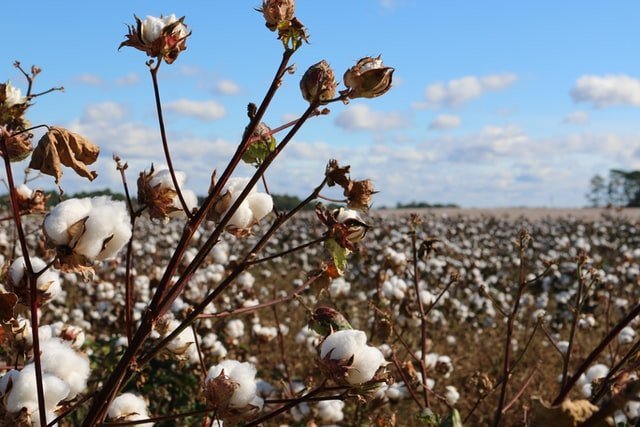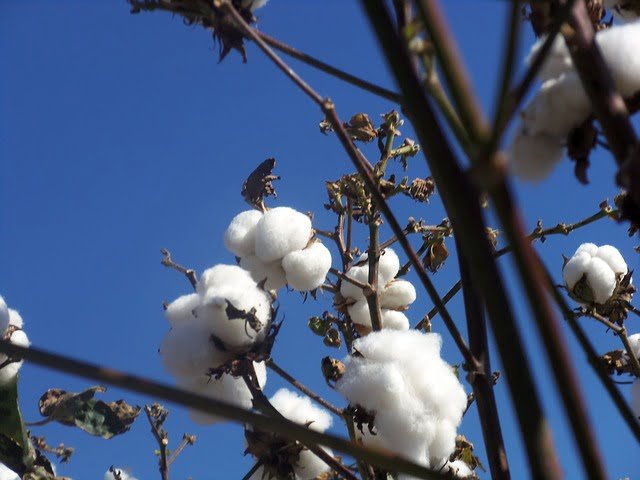This ultimate guide on cotton farming will help you to learn cultivating cotton in your farm. Get to know best practices of cotton farming from this article.
The world prefer cotton over any other fibre in the world. Hence with increasing population every year, the demand for cotton keeps increasing. Cotton crop is a key material in world’s economy. Over 150 countries are involved in exports and imports of cotton fibre.
By adopting better farm practices, you can earn around 700 $ from one acre of land devoted to cotton farming. According to the Business Research Company in the year 2017, the value of global cotton market was $ 63.6 Billion.
Let’s now know more about cotton crop.
Table of Contents
Introduction
Cotton is not only a fibre crop but it is also designated as the King of fibre crops. Agriculturists and farmers also call cotton as “white gold.” Practicing cultivation of cotton can result in generating employment for 200 man-days per hectare.
Cotton fibre have a huge demand in clothing and textile industry. Industrialists use raw cotton fibre to make useful products such as towels, jeans, socks, under wears, T-shirts, etc. People prefer cotton made products as they are comfortable, less toxic, and hypoallergenic.
However, cotton seed is also a useful product. It is used to make cottonseed oil. By growing cotton, you will not only earn money but also self satisfaction by adding quality in customer’s life.
Botanical Classification
Botanical Name: Gossypisum hirsutum, G. barbadense, G. arboreum, G. herbaceum
Family: Malvaceae
Order: Malvales
Class: Magnolipsida
Division: Magnoliophyta
Chromosome Number: 26 (n=13)
Source: usda.plants.gov
Origin Of Cotton
Different species of cotton originated at different places. Researchers believes that arboreums originated in India. While herbaciums originated in Arabia or Southern Africa. Later on travellers introduced this species in western India.
The barbadense species originated and evolved in South America. However, hirsutum species originated near the border of Mexico and Guatemala.
Area & Production
Globally around 26 Million tonnes of cotton was produced in the year 2019. India is the largest producer of cotton fibre in the world. During the year 2018 to 2019 it produced around 6,188,000 tonnes of cotton.
China comes second with production of around 6,178,318 tonnes in the year 2019. Other top cotton producing countries are United States Of America, Pakistan, Brazil, Uzbekistan, Australia, etc.
Around 33.14 Million hectares of land is used for cultivating cotton globally. In India, around 11.7 Million hectares of land is used for growing cotton.
Cotton Farming Guide

For successful cultivation of cotton, you need to know better farming practices. Moreover, get to know soil, climate, irrigation, fertilizers, requirements etc.
Soil Requirements
You can grow cotton crop in alluvial, black, red sandy, loamy, or laterite soil. Cotton crop cannot withstand waterlogging. You can cultivate rainfed cotton crop in deep black to medium black soil.
In alluvial soil or light soil you can cultivate irrigated cotton crop. Cotton can grow in slightly acidic soil. Soil pH range of 5.5 to 6.0 is ideal for cultivating cotton crop.
Climate & Temperature
Cotton crop can grow in tropical to sub-tropical climates. Climatic factors play crucial role in growth of cotton crop. At least 500 mm of water is required annually for successful farming of cotton. For germination of seed soil temperature of around 18 degrees Celsius is ideal.
Soil temperature below 20 degrees Celsius can result in reduced root growth. For good vegetative growth, soil temperature of around 21 to 27 degrees Celsius is ideal. During fruiting, temperature range of 27 to 32 degrees Celsius results in increased yield.
But temperature above 35 degrees Celsius can result in reduced yield.
You will also love reading these,
READ MORE: KIWI FARMING GUIDE
READ MORE: BANANA FARMING GUIDE
Field Preparation
For raising rainfed crop in black soil you can prepare field by harrowing 3 to 4 times by blade harrow. You can give deep ploughing once in 4 to 5 years. This will help to control perennial weeds.
For raising rainfed kharif cotton crop in red or laterite soil, prepare field by ploughing 2 to 3 times. But for Rabi crop harrowing 2 to 3 times is necessary.
For raising irrigated crop plough the field once after giving initial irrigation.
Seed Rate & Spacing
Seed rate of cotton depends on cultivars, soil type and cultural practices. In case of delayed sowing and heavy weed infestation, closer spacing is considered ideal. In one hectare of land you can grow 50,000 to 1,00,000 cotton plants for better results.
Recommended seed rate and spacing according to ICAR is given below:
G. hirsutum
| Condition | Fuzzy Seeds | Delinted Seeds | Spacing |
|---|---|---|---|
| Irrigated | 10 to 20 Kilograms/hectare | 6 Kilograms/hectare | 75 × 15 Centimetres |
| Rainfed | 15 Kilograms/hectare | 5 Kilograms/hectare | 60 × 30 Centimetres |
G. arboreum
| Condition | Fuzzy Seeds | Delinted Seeds | Spacing |
|---|---|---|---|
| Irrigated | 10 Kilograms/hectare | 4 Kilograms/hectare | 60 × 30 Centimetres |
G. herbaceum
| Condition | Fuzzy Seeds | Delinted Seeds | Spacing |
|---|---|---|---|
| Rainfed | 12 Kilograms/hectare | 4 Kilograms/hectare | 45 × 30 Centimetres |
G. barbadense
| Condition | Fuzzy Seeds | Delinted Seeds | Spacing |
|---|---|---|---|
| Irrigated | 8 Kilograms/hectare | 3 Kilograms/hectare | 90 × 30 Centimetres |
Hybrid Varieties
| Condition | Delinted Seeds | Spacing |
|---|---|---|
| Irrigated | 2 Kilograms/hectare | 90 × 60 Centimetres |
| Rainfed | 2 Kilograms/hectare | 120 × 60 Centimetres |
Seeding Method
You can sow seeds on flat beds under rainfed condition by using seed drill, dibble, or country plough. In case of irrigated crop hand dibbling is recommended. Do not forget to take care of spacing in both conditions.
Irrigation
Irrigation frequency depends mainly on type of soil and crop growth stages. However in all condition, you can give first irrigation immediately after sowing of seeds.
During germination phase (1 to 15 days), give second irrigation 5 days after sowing(DAS) of seeds. This will facilitate the seedlings to emerge out and grow.
Vegetative phase continues from 16 to 44 days. During this phase apply first irrigation 20th to 21st day after sowing of seeds in case of both heavy and light soil. You can give second irrigation on 35th DAS in case of light soil.
But in case of heavy soil, give second irrigation on 40th DAS.
Flowering phase can vary among hybrids and local species. Generally it starts from 45 DAS and ends around 90 to 100 DAS. You can follow this table recommended by Tamil Nadu Agriculture University to irrigate your field during flowering phase.
| Irrigation | Light Soil | Heavy Soil |
|---|---|---|
| 1st Irrigation | 48 DAS | 55 DAS |
| 2nd Irrigation | 60 DAS | 70 DAS |
| 3rd Irrigation | 72 DAS | 85 DAS |
| 4th Irrigation | 84 DAS | 100 DAS |
| 5th Irrigation | 96 DAS | – – – – |
You can adopt skip furrow irrigation or alternate furrow irrigation in case of heavy soils. Adopting skip furrow irrigation system will help to save 50% of the total water required to grow cotton.

Manures & Fertilizers
You can add 12.5 tonnes of any bulky organic manure or 2.5 tonnes of vermicompost before field preparation or ploughing. Along with this you can also apply Azospirillum @2 Kilograms per hectare. And add Phosphorus solubilising bacteria and Pink pigmented facultative methylotropics.
Apply @2.0 Kilograms per hectare of each of them as basal application.
Get your soil tested for deciding inorganic fertilizer requirement. Cotton crop on an average requires 100 to 120 Kg N, 60 to 70 Kg P2O5 and 80 Kg K2O per hectare.
You can apply 50% nitrogen, potassium and 100% phosphorus as basal doze during field preparation. For local species apply rest 50% of N and K 45 DAS. For hybrid variety apply rest 50% Nitrogen in two split dozes.
Apply first doze at 45th DAS and second doze 60th DAS. You can also apply 12 Kg micronutrient mixture per hectare to improve crop yield.
Harvesting
You can harvest cotton either with hand or by machines. Harvesting with hand is a slow process but it allows to get better cotton fibre. Start picking balls once they are fully mature.
Practice harvesting during mornings. Because due to presence of moisture in the environment dry leaves and bracts do not stick to the ball. You can harvest at frequent intervals of 7 days.




